Das Erstellen klarer und aussagekräftiger URLs ist für die SEO von WordPress unerlässlich. Permalinks sind die Webadressen, die einzelne Beiträge, Seiten und andere Inhalte auf Ihrer Website identifizieren.
Gut strukturierte Permalinks bieten mehrere Vorteile. Beschreibende Permalinks, die relevante Schlüsselwörter enthalten, können Suchmaschinen dabei helfen, Ihre Inhalte zu verstehen und effektiv einzustufen, und benutzerfreundliche Permalinks sind für die Menschen leichter zu teilen und zu merken.
Bei WPBeginner haben wir festgestellt, dass das Anpassen von Permalinks, um beschreibender und benutzerfreundlicher zu sein, die SEO unserer Website und die Erfahrung der Benutzer verbessert hat.
In diesem Artikel erfahren Sie, wie Sie individuelle Permalinks in WordPress erstellen können, um die Benutzerfreundlichkeit zu erhöhen und die Suchmaschinenoptimierung zu verbessern.
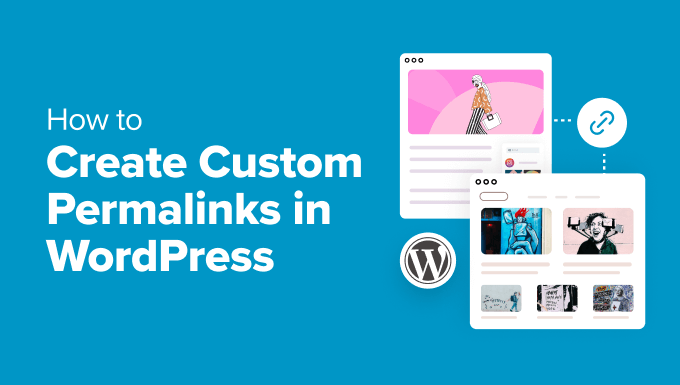
Da dies ein umfassendes Tutorial zum Erstellen von benutzerdefinierten Permalinks in WordPress ist, haben wir ein übersichtliches Inhaltsverzeichnis erstellt:
- What Is a Custom Permalink in WordPress?
- How to Change the WordPress Permalink Structure
- How to Change the Category and Tag URL Prefix in WordPress
- How to Change an Individual WordPress Post or Page URL
- How to Change a WordPress Category or Tag URL
- How to Change an Author Page URL in WordPress
- How to Create Completely Custom Permalinks in WordPress
- How to Set Up Permalink Redirects and Avoid 404 Errors
- Frequently Asked Questions About Custom Permalinks
Was ist ein benutzerdefinierter Permalink in WordPress?
Permalinks sind die permanenten URLs Ihrer einzelnen Blogbeiträge, Seiten und anderen Archivseiten auf Ihrer WordPress-Website.
Das Ziel Ihres Permalinks ist es, eine leicht verständliche URL-Struktur sowohl für Menschen als auch für Suchmaschinen zu erstellen. Hier ist ein Beispiel:
https://example.com/best-refrigerators-for-tiny-kitchens/ |
Diese URL ist viel einfacher zu verstehen als die URLs von früher, die so aussahen:
https://example.com/index.php?p=4556 |
WordPress bietet Website-Besitzern mehrere Optionen für Permalinks zur Auswahl an. Sie können diese anzeigen, indem Sie die Seite Einstellungen ” Permalinks in Ihrem WordPress-Administrationsbereich aufrufen.
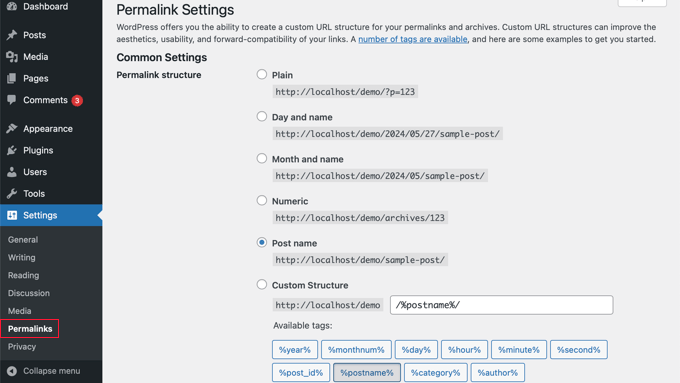
Neben der Kurzmitteilung der Haupt-Permalinks-Struktur bietet WordPress auch Möglichkeiten, die individuellen URLs von Beiträgen, Seiten, Kategorien, Schlagwörtern und anderen Bereichen Ihres Blogs anzupassen.
Sie können auch WordPress Plugins verwenden, um ganz individuelle Permalinks für bestimmte Abschnitte Ihrer Website zu erstellen, die die Standardeinstellungen von WordPress außer Kraft setzen.
Schauen wir uns also alle Optionen nacheinander an. Wir beginnen mit den standardmäßig integrierten Optionen, die mit Ihrer WordPress Website geliefert werden.
So ändern Sie die WordPress-Point-Struktur
Wenn Sie die gesamte URL-Generierungsvorlage für Ihre Website ändern möchten, gehen Sie auf die Seite Einstellungen ” Permalinks in Ihrem WordPress-Dashboard, die wir oben erwähnt haben.
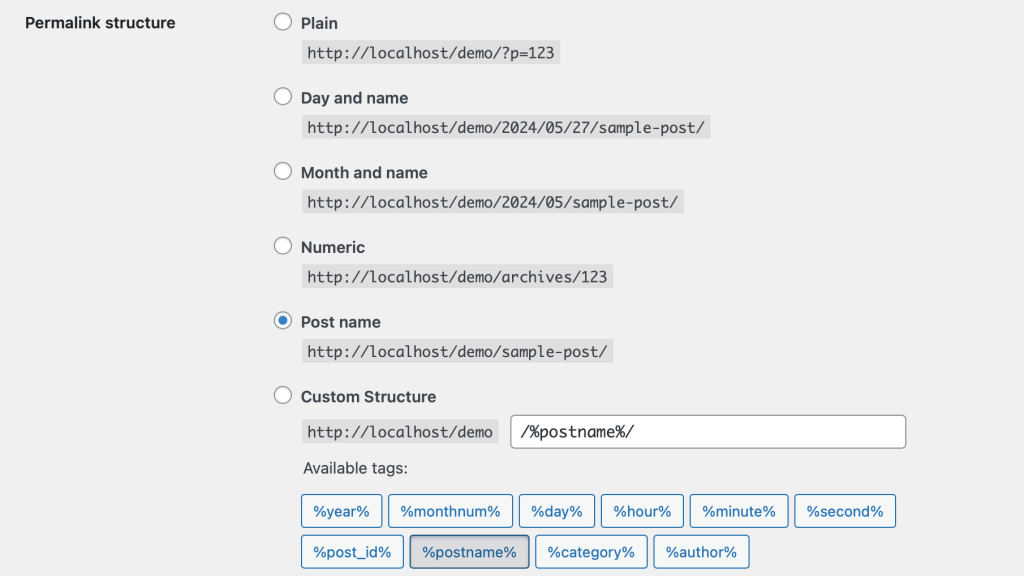
Hier können Sie eine URL-Struktur für Ihre einzelnen Beiträge auswählen. Sie können auch die auf dem Bildschirm angezeigten Tags verwenden, um eine eigene Struktur für Ihre WordPress-URLs zu erstellen.
Sie könnten zum Beispiel den Titel des Beitrags %postname% und die Kategorie %category% sowie das Jahr %year%, in dem der Beitrag veröffentlicht wurde, verwenden.
Vergessen Sie nicht, auf den Button “Änderungen speichern” am Ende der Seite zu klicken, um Ihre Änderungen zu speichern.
Wir empfehlen die Verwendung einer URL-Struktur, die den Namen des Beitrags in der URL enthält. Dies macht Ihre URLs benutzerfreundlicher und kann Ihre WordPress-SEO verbessern.
Stellen Sie sicher, dass Sie SEO-freundliche Permalinks wie diese verwenden, wenn Sie einen neuen WordPress-Blog oder eine neue Website erstellen.
Wenn Sie jedoch eine bestehende Website haben, die bereits von Suchmaschinen besucht wird, kann das Ändern von Permalinks Ihren SEO-Rankings schaden.
Ändern des Kategorie- und Tag-URL-Präfixes in WordPress
WordPress verwendet standardmäßig /category/ als Basis für Ihre Kategorie-URLs und /tag/ für die Tags-Seiten.
Hier sind einige Beispiele:
https://example.com/category/technology/https://example.com/tag/fintech/ |
Sie können diese Basispräfixe ändern, indem Sie zu Einstellungen ” Permalinks gehen und einfach neue Präfixe eingeben. Sie könnten zum Beispiel “Kategorie” in “Themen” und “Schlagwort” in “Hashtag” ändern, etwa so:

Stellen Sie sicher, dass Sie auf die Schaltfläche “Änderungen speichern” klicken, um Ihre Kategorie- und Tag-Basis zu aktualisieren.
Jetzt haben Sie eine neue Kategorie und Tag-Basis auf Ihrer Website aktiv, wie diese:
https://example.com/topics/technology/https://example.com/hashtag/fintech/ |
So ändern Sie die URL eines einzelnen WordPress-Beitrags oder einer Seite
Sobald Sie Ihre anfängliche Permalink-Struktur eingerichtet haben, wird WordPress sie als Template für alle Links auf Ihrer Website verwenden.
Sie können jedoch auch die URL-Titelform innerhalb der URL-Struktur für einzelne Beiträge, Seiten und individuelle Inhaltstypen ändern, um sie SEO-freundlicher zu gestalten.
Sie können die Titelform der URL in der Ansicht zur Bearbeitung der Beiträge im WordPress Editor individuell anpassen.
Wenn Sie einen neuen Beitrag oder eine neue Seite erstellen, müssen Sie zunächst auf “Veröffentlichen” oder “Aktualisieren” klicken, um Ihren Entwurf zu speichern.
Danach klicken Sie einfach auf “URL” im Abschnitt “Zusammenfassung” in den Einstellungen des Beitrags.
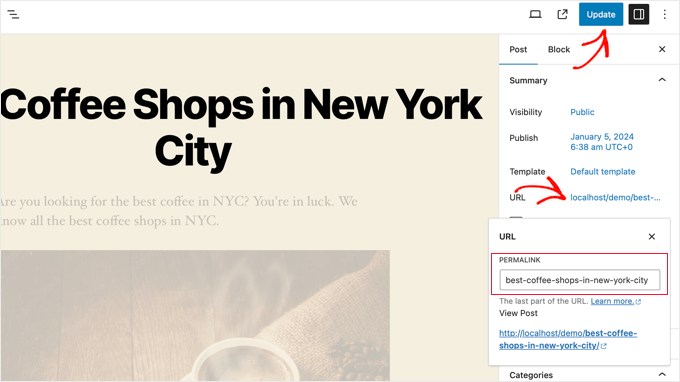
Ändern Sie dann die Titelform der URL des Beitrags in eine individuelle Permalinkform.
Wenn Sie fertig sind, klicken Sie auf die Schaltfläche “Aktualisieren”, um den neuen Permalink zu speichern.
Sie können diese Methode für alle Inhaltstypen verwenden, einschließlich WooCommerce-Produkten, Websites mit Mitgliedschaft, Online-Kursen und mehr.
So ändern Sie eine WordPress-Kategorie oder Tag-URL
Im vorherigen Schritt haben wir Ihnen gezeigt, wie Sie das Basispräfix für Kategorien und Schlagwörter in WordPress ändern können. In diesem Schritt zeigen wir Ihnen, wie Sie die URL-Schlüsselwörter für eine einzelne Kategorie oder ein Schlagwort ändern können.
Gehen Sie einfach in Ihrem WordPress-Dashboard auf Beiträge ” Kategorien und klicken Sie dann auf den Link “Schnellbearbeitung” unterhalb der Kategorie, die Sie individuell anpassen möchten.
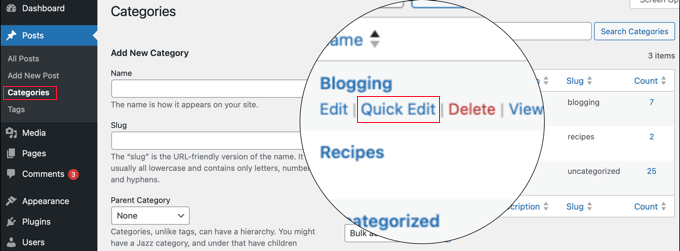
WordPress lädt nun die Details der Kategorie.
Von hier aus können Sie den Slug der Kategorie ändern, um den Permalink anzupassen.
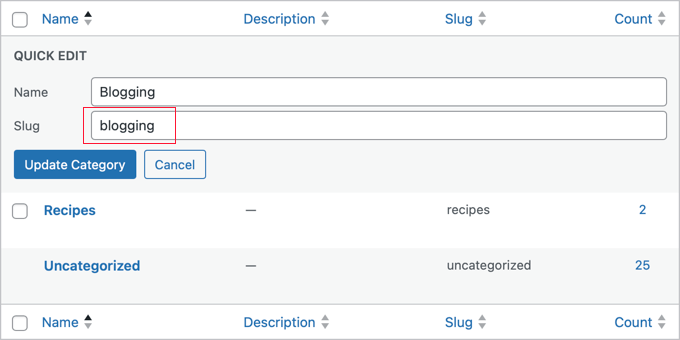
Klicken Sie unbedingt auf den Button ‘Kategorie aktualisieren’, um die Änderungen der Titelformen Ihrer Kategorie zu speichern.
Auf ähnliche Weise können Sie ein einzelnes Tag bearbeiten, indem Sie zum Bildschirm Beiträge ” Tags gehen und die gleichen Schritte ausführen.
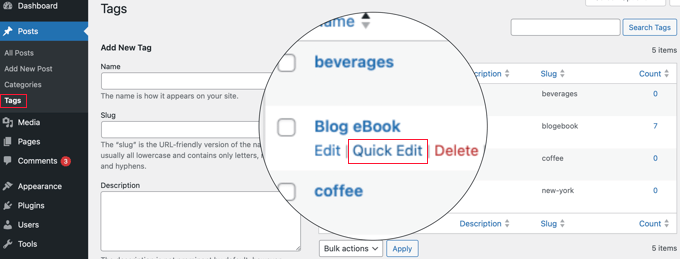
Sie können auch alle individuellen Taxonomien mit der gleichen Methode wie oben bearbeiten.
Wie man die URL einer Autorenseite in WordPress ändert
WordPress erstellt automatisch eine URL für die Autorenseite für die verschiedenen Autoren auf Ihrer Website. URLs für Autorenseiten sehen so aus:
https://example.com/author/jsmith/ |
Im obigen Beispiel ist jsmith die Titelform, und author ist die Basis.
Das Problem ist, dass WordPress keine Option zum Ändern der Basis-URL des Autors oder der Titelform bietet. Glücklicherweise können Sie dies mit einem WordPress Plugin mit ein paar Klicks ändern.
Als Erstes müssen Sie das Plugin ” Edit Author Slug” installieren und aktivieren. Details finden Sie in unserer Schritt-für-Schritt-Anleitung zur Installation eines WordPress-Plugins.
Gehen Sie nach der Aktivierung auf die Seite Benutzer ” Alle Benutzer in der WordPress-Verwaltung. Klicken Sie dann auf den Link “Bearbeiten” unterhalb des Benutzernamens.
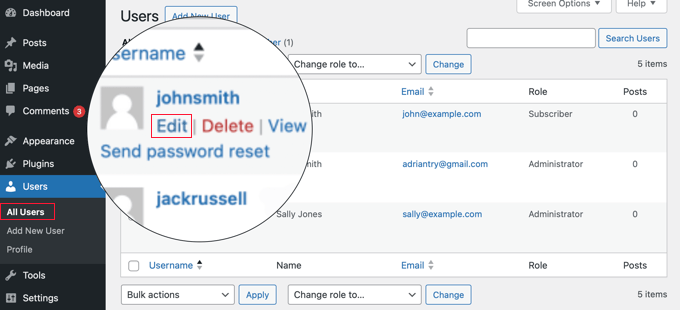
Blättern Sie auf der nächsten Seite nach unten zum Abschnitt “Autorenslogan bearbeiten”.
Hier können Sie einen Autorenslogan auswählen oder im Feld “Benutzerdefiniert” Ihren eigenen hinzufügen.
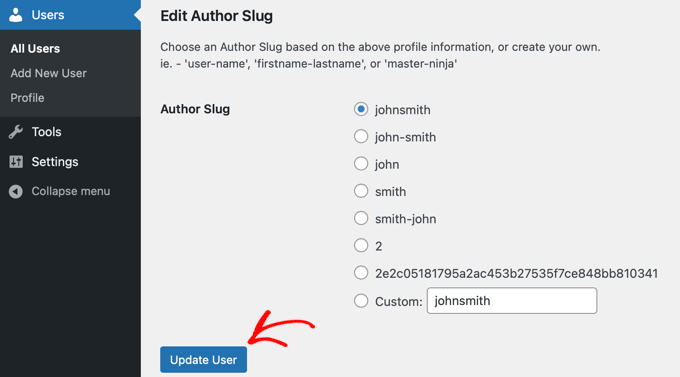
Vergessen Sie nicht, auf die Schaltfläche “Benutzer aktualisieren” zu klicken, um Ihre Permalink-Einstellungen zu speichern.
Wenn Sie die Basis des Autoren-Permalinks ändern möchten, gehen Sie einfach auf Einstellungen ” Autorenslogan bearbeiten.
Hier sehen Sie eine Option, um die Autorenbasis zu ändern und sogar verschiedene Autorenbasen für Benutzer mit unterschiedlichen Benutzerrollen auszuwählen.
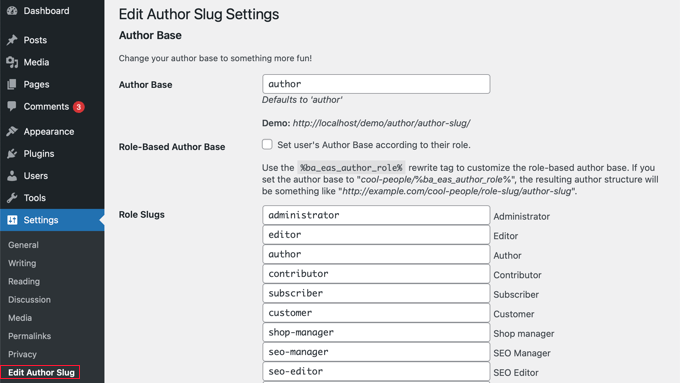
Weitere Einzelheiten finden Sie in unserer Anleitung zum Ändern des Slugs und der Basis der Autoren-URL in WordPress.
Wie man vollständig benutzerdefinierte Permalinks in WordPress erstellt
Mit allen oben genannten Methoden können Sie die WordPress-Permalinks bis zu einem gewissen Grad anpassen. Sie können Ihnen jedoch nicht helfen, vollständig benutzerdefinierte Permalinks zu erstellen.
Das liegt daran, dass WordPress diese Funktion nicht standardmäßig anbietet.
Glücklicherweise gibt es ein Plugin, das dabei helfen kann. Wenn Sie die standardmäßige WordPress-URL-Struktur für bestimmte Abschnitte auf Ihrer Website außer Kraft setzen möchten, dann ist dies genau das Richtige für Sie.
Als Erstes müssen Sie das Plugin ” Custom Permalink Editor” installieren und aktivieren. Weitere Details finden Sie in unserer Anleitung für Anfänger zur Installation eines WordPress Plugins.
Nach der Aktivierung müssen Sie den Beitrag öffnen, für den Sie einen benutzerdefinierten Permalink erstellen möchten.
Anstatt den Permalink wie oben zu bearbeiten, finden Sie dann unterhalb des Editors in der Box ‘Custom Permalink Editor’ die Option, einen individuellen Permalink zu erstellen.
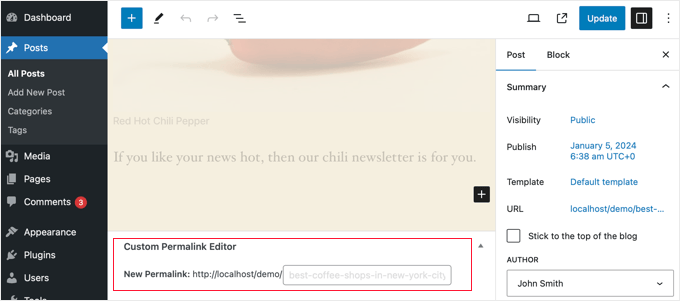
Der individuell angepasste Permalink kann Bindestriche, Bindestriche oder alles andere enthalten, was Sie möchten. Sie können die WordPress-Permalinks-Struktur vollständig überschreiben. Hier sind ein paar Beispiele:
https://example.com/seo-friendly-urlhttps://example.com/seo/friendly/urlhttps://example.com/seo-friendly/url |
In ähnlicher Weise können Sie auch benutzerdefinierte Permalinks für Kategorien erstellen.
Gehen Sie dazu auf die Seite Beiträge ” Kategorien und klicken Sie auf den Link “Bearbeiten” unterhalb der Kategorie, die Sie ändern möchten.
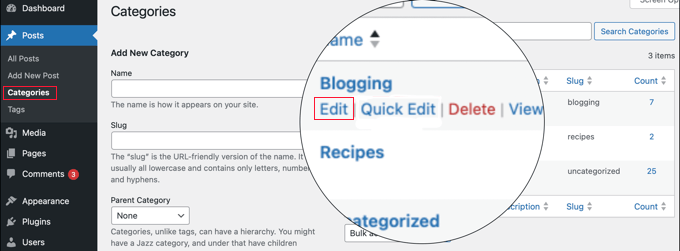
Auf der Seite mit den Kategoriedetails finden Sie die Option, einen benutzerdefinierten Permalink für diese bestimmte Kategorie zu erstellen.
Sie können sogar eine URL ohne das Basispräfix der Kategorie erstellen.
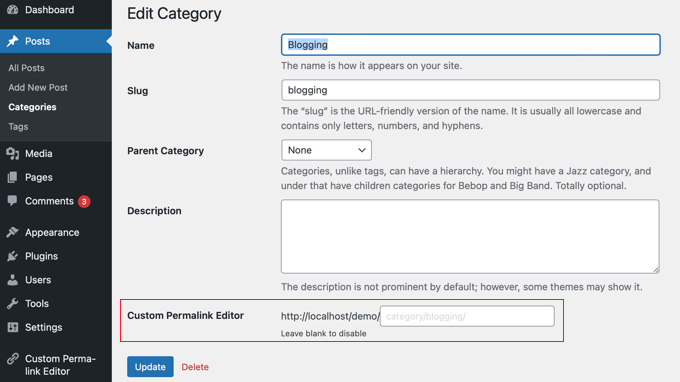
Um die individuellen Permalinks zu deaktivieren, lassen Sie das Feld ‘Custom Permalink Editor’ einfach leer.
Sie können auch alle Ihre individuellen Permalinks deaktivieren, indem Sie das Plugin einfach abschalten.
Wie man Permalink-Umleitungen einrichtet und 404-Fehler vermeidet
Wenn Sie Änderungen an Ihrer Permalink-Struktur oder Titelformen für Autoren vorgenommen oder ganz individuelle Permalinks erstellt haben, kann es zu 404-Fehlern kommen.
Um dies zu beheben, müssen Sie eine Permalink-Umleitung von Ihren alten zu den neuen Permalinks einrichten.
Der einfachste Weg, dies zu tun, ist die Verwendung des All in One SEO Plugins. Es ist das beste WordPress SEO Plugin und wird von über 3 Millionen Websites verwendet, um ihre SEO zu verbessern.
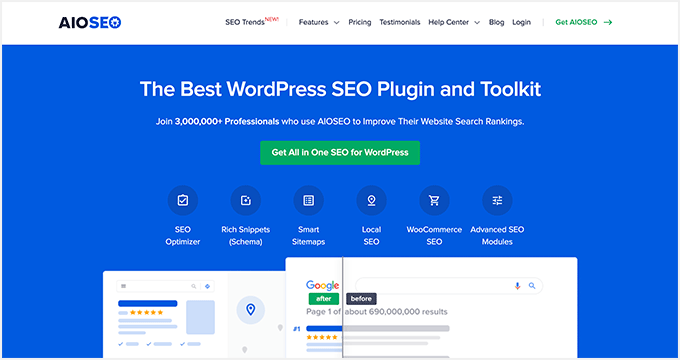
Es verfügt über einen leistungsstarken Weiterleitungsmanager, mit dem Sie 301-Weiterleitungen für Ihre Permalinks verwalten, 404-Fehler verfolgen und beheben können, und vieles mehr.
Weitere Einzelheiten zum Einrichten von Permalink-Weiterleitungen finden Sie in unserem Leitfaden für Einsteiger zum Erstellen von 301-Weiterleitungen in WordPress.
Nach der Aktivierung können Sie neue Permalink-Weiterleitungen direkt von Ihrem WordPress-Dashboard aus verwalten und erstellen.

Kurzmitteilung, AIOSEO hilft Ihnen auch, 404 Fehler Seiten zu verfolgen und zu beheben. Wenn Sie zufällig einige Weiterleitungen übersehen, können Sie diese später leicht finden und beheben.
Häufig gestellte Fragen zu individuellen Permalinks
Nachdem wir uns nun damit beschäftigt haben, wie man individuelle Permalinks erstellt, wollen wir nun ein paar häufig gestellte Fragen zu diesem Thema beantworten.
Was sind Permalinks in WordPress?
Permalinks sind die permanenten URLs für Ihre WordPress-Beiträge, -Seiten und -Kategorien. Sie bestimmen, wie Ihr Inhalt in der Adressleiste eines Browsers und auf den Seiten der Suchmaschinenergebnisse (SERPs) angezeigt wird.
Warum sollte ich individuelle Permalinks erstellen?
Individuell angepasste Permalinks können benutzerfreundlicher und SEO-freundlicher sein. Sie können dazu beitragen, dass Besucher den Inhalt Ihres Beitrags anhand der URL selbst verstehen. Sie können auch das Ranking Ihrer Website in den Suchergebnissen verbessern.
Kann ich den Permalink für nur einen Beitrag ändern?
Ja, Sie können die Permalinks für jeden Beitrag individuell im Einstellungsbereich des WordPress Block-Editors bearbeiten.
Was ist die SEO-freundlichste Permalink-Struktur?
Die am meisten empfohlene Struktur ist die Option “Beitragsname”. Mit dieser Struktur werden URLs erstellt, die den Titel des Beitrags verwenden. Dies ist für Menschen leichter zu verstehen und wird von Suchmaschinen bevorzugt.
Was passiert mit meinen alten Permalinks, wenn ich die Struktur ändere?
Wenn Sie die Permalink-Struktur ändern, ändern sich auch die URLs für alle bestehenden Beiträge und Seiten. Dies kann Ihre Suchmaschinenoptimierung beeinträchtigen, wenn Sie keine 301-Weiterleitungen einrichten.
Muss ich Weiterleitungen einrichten, wenn ich die Struktur ändere?
Ja, wir empfehlen Ihnen dringend, Weiterleitungen einzurichten, um sicherzustellen, dass Benutzer und Suchmaschinen nach der Änderung auf den richtigen URLs landen. Plugins wie All in One SEO und Redirection können Ihnen helfen, Weiterleitungen einfach zu verwalten.
Wir hoffen, dieser Artikel hat Ihnen geholfen zu lernen, wie man individuelle Permalinks in WordPress erstellt. Vielleicht interessieren Sie sich auch für unsere Anleitung zum Hinzufügen von Schlüsselwörtern und Meta-Beschreibungen in WordPress oder für unsere Expertenauswahl der besten Werkzeuge zur Überprüfung von Backlinks, um zu sehen, wer auf Ihre Website verlinkt.
Wenn Ihnen dieser Artikel gefallen hat, dann abonnieren Sie bitte unseren YouTube-Kanal für WordPress-Videotutorials. Sie können uns auch auf Twitter und Facebook finden.





Jiří Vaněk
I knew some of the settings from WordPress, but some I didn’t even know could be adjusted like this. For example, changing the author URL with a permalink looks great. Is it possible to do this other than using a plugin? I would like to avoid a lot of plugins.
WPBeginner Support
While possible it is difficult which is why we recommend the plugin, for your concern on the number of plugins we would recommend taking a look at our article below:
https://www.wpbeginner.com/opinion/how-many-wordpress-plugins-should-you-install-on-your-site/
Admin
Jiří Vaněk
I read the article. I currently have around 30 plugins and it feels like a lot for me. Although I have my own server with 8GB of ram for one website, I try to use some kind of compromise even with regard to WordPress updates. The fewer plugins, the less chance something will break when you update. But I understand. Thank you for answer.
Tasin
Bro I do not have the permalink editor in the post editor sidebar. Why is that? I am using the latest version of WordPress. I can edit url in classic editor but not in block editor.
WPBeginner Support
We would recommend checking your preferences in the post editor to ensure you do not have that section hidden as a likely reason.
Admin
Robert
After adding the link to subcategories, WP changes to: /?product_cat=
How is it possible to change it?
WPBeginner Support
That looks like you are using an eCommerce plugin, you would want to check further down the permalinks page or in the plugin’s settings for modifying those permalinks.
Admin
Vivek
Hello,
To rank my news website on Google News, do I need to use the permalink link Iike postname-postID?
Because I see most of the news website uses this format?
WPBeginner Support
While not required, that is the normal preferred permalink setting.
Admin
Jacob Corbett
Hi WP Beginner,
Great article! I have already made multiple pages with a theme and I want to change all their permslinks. Every time I do it I get a 404 on the updated page.
WPBeginner Support
You would likely need to resave your permalink settings and redirect your old posts/pages if you wanted.
Admin
Haseeb Nazir
Hi,
If we use custom permalink plugin does it affect our website SEO in any case?
WPBeginner Support
It would depend on what you do with the plugin, using the plugin to make the same change you would do manually would not be different than using the plugin if that is what you mean
Admin
Katie
I see that this post was originally from 2016. Would you still recommend using Custom Permalinks as the plugin for this? When i went to add the plugin it says “Untested with your version of WordPress” and the last update was a year ago. Would love to know if this is still recommended.
WPBeginner Support
For that not tested warning, you would want to take a look at our article below for our opinion on that:
https://www.wpbeginner.com/opinion/should-you-install-plugins-not-tested-with-your-wordpress-version/
Admin
A K P
Hi,
I have old website and now I change my Permalink Settings setting from date pattern to post name.
will it change old links too?
Site is performing good in google. I don’t want to change old setting.
But new post with Post name Permalink Settings.
WPBeginner Support
The link to the post itself would change but links to the post at the old location would not update and would cause 404 errors for anyone using those links.
Admin
swati
really helpful very very thanks.
WPBeginner Support
You’re welcome
Admin
WONDER APATI
Hello, I read your post on how to migrate from blogger to WordPress. One of the things that I see as the issue here is the link structure and AdSense.
Assuming that I migrate from blogger to WordPress without setting the link to month and day as you recommended in the other post but rather choose to edit each post I migrated from blogger to match the month and day, will that work?
Otherwise, all other posts I published will maintain the posts URLs except those imported from blogger(they would be edited to match the month and day) will that be ok
WPBeginner Support
If you change your permalinks then you would need to create redirects to prevent your visitors from seeing 404 errors.
Admin
Yolandie
Thank you so much for the help. Building my page day by day and these info help lots
WPBeginner Support
Glad our guides can help
Admin
Adhyansh Jadli
Thank you very much for such a nice article. I was finding way to set up categories and tags. I am regular follower of your blog and youtube channel.
It is the best platform i had ever seen, which provide detailed info for newbie like me.
You helped me to setup my wordpress.
Thanks a lot SYED BALKHI sir
Adhyansh Jadli
WPBeginner Support
You’re welcome, glad our content can be helpful
Admin
Pawan Khadka
Is there any post that guide me to create query based url example :
Main Content: example.com/this-is-my-post (Page With main content)
Download page: example.com/this-is-my-post?download (page with download links)
WPBeginner Support
Unless I hear otherwise, we do not have a recommended method to set up that kind of permalink
Admin
Couper
Is there any way to remove the /home from the end of my URL without plugins on the Premium version?
WPBeginner Support
If you mean it is on every page then you would want to take a look at: https://www.wpbeginner.com/wp-tutorials/how-to-get-rid-of-wordpress-from-your-wordpress-site-url/
Admin
Marina28
What can we do for the urls tha are not post and pages for example in a forum plugin that I embed I can not edit the urls for it. There is any file in wordpress that I can edit each one url ??
WPBeginner Support
You would want to reach out to the support for that specific plugin for how to modify the permalinks for its additions.
Admin
Ferdin Norbert
Hi, Nice post. Currently, I am working on a project where I wanted to change an in built tab called promotions and I did this programmatically, I was successful in renaming the promotions tab to Notification tab. But the only thing left is its permalink. I want to change MyAccount/Promotions to MyAccount/Notifications. Is there any way to achieve this? Please reply as soon as possible.
Thank you
WPBeginner Support
It would depend on what is creating the account, if you reach out to the support for the plugin you are using they should be able to let you know.
Admin
Quy
Excellent article!
WPBeginner Support
Thanks!
Admin
ASHOK KUMAR SONAWAT
Thanks today my problem is solved after reading this article…
WPBeginner Support
You’re welcome
Admin
Alex Hoyle
Hello. I just made a WordPress website for my blog. How do I change the permalink to use the primary domain instead of starting with the temp.domain?
WPBeginner Support
You would want to check under Settings>General to see what your domain is set as, if it is on your temporary domain there then normally you can reach out to your hosting provider to help you update from your temporary domain to the correct address without issue
Admin
The Thus
Hello WPBeginner,
I have configured and setup as you have shown in article but still my articles are ranking in Google domain.com/category ,may I know how to solve this issue ??
WPBeginner Support
Google may have cached the old structure if you changed it. You could use Google’s URL removal tool if you wanted to remove those results in Google search.
Admin
Geet
I want to structure my new website like this –
my-company.com/main-page
my-company.com/main-page/supporting-article-1
my-company.com/main-page/supporting-article-2
my-company.com/main-page/supporting-article-3
Is it possible to create this structure using Custom Permalinks plugin?
WPBeginner Support
The plugin should allow you to change the permalink to anything so it should be able to set up that permalink structure.
Admin
Mike Coleman
I have a new website (unpublished as yet) and want to have a home page. However, when I attempt to create a page with just that URL Permalinks adds an unfathomable number to the URL eg – example.com.au/123-2.
I’ve tried altering the Permalink settings but that alters the code after the / to whatever the settings dictate.
How do I create a page with just the URL and no / or additions after the /?
regards
Mike
WPBeginner Support
If you want to have a specific page appear when it is just the url without the slashes then you would set the home page under Settings>Reading
Admin
Geetanjali
Hi I have shifted my blog from blogger to wordpress. My permalink set to month and post. But now for new post I want the permalink to be post only. So after reading this aricle I have installed custom permalinks plugin but while editing the new post I don’t see the option to change the month and post from slug. Please suggest what can be done for changing the new post and coming post permalink to post only instead of month and post.
Tucker Daugh
I’ve been told by developers to not change permalinks at the “EDIT” level. I have some pages on a site I helped build that really could benefit with a name change. Something that reflects what a person may be searching for vs something we were trying to be clever with. So, question: What causes permalinks to “break” if you change them at that edit stage (When you open a page and see the URL). I would assume if I am careful and do_something_like_this than I’m okay, right?
WPBeginner Support
Hi Tucker,
When you change a page’s URL by editing it, your page would work fine on your website. However, your old URL would be indexed by search engines and they will not be able to find it. If you must change the permalink of an existing page, then you need to set up a redirect.
Admin
Talkgeria
Thanks for sharing this helpful post.
My problem is that my blog posts shows mysite.com/category instead of mysite.com/postname on search result but shows the post name once you click on it. my question now is, how do i make the post name to appear on search result as well?
kenneth khayyam
nice article very helpful for beginners
Vidya
Hi
i have a page which compares different products. permalink of the same is /page-name/?compareids=1,2,3
can you please suggest me about how to customize permalink of this kind of pages so to display permalink like : /page-name/compare-productname1-vs.-productname2-vs.-productname3
Prashant Chevale
Hello Team,
I have an query,
1.How to implement keywords in url before creating post & after creating post?
2.How to implement keywords in Posts url without creating 404 error in WordPress?
3. Without creating 404 error how to optimise urls?
4.I want permalink customise ( insert keyword in url ) without any error how can I set that?
please help me…
Thank you.
Orit Adar
My entire site is still under maintenance, but most of my posts are defined as “published” in that setup. If I want to change the slugs can I just revert the status to “draft” temporarily, change the slug and then re-“publish”? I guess I do not understand the meaning of the word “publish” as long as the site is not alive, but it helps to see the posts better s I did it. Thank you.
WPBeginner Support
Hi Orit,
If your site is not live and your content is not indexed by search engines, then you can change the slug of a live page/post as well.
Admin
Adell
My site is new and under construction -not live. I’ve created a couple posts and published them, but my site is not live. Can i keep changing the slug , permalinks, and category tags, without needing the re-direct plug in?
Is it safe to keep making changes to the permalink as long as my site is not live (even though i clicked ‘publish’?
Do i only need the redirect plug in if i make changes tot the permalnk after the site goes live?
thank you!!
Nnamdi
I would like to know how to create a page name before the website url example customname.yoursitename.com. i don’t know how else to describe this sorry for any misunderstanding.
WPBeginner Support
Hi Nnamdi,
These are called subdomains. They are not like pages at all. In fact, a subdomain could be a totally different website using the same root domain name.
Admin
Brandy
Hi, when a do this process, the /blog does not appears in the breadcumbs. What can I do?
I want my blog:
example.com/blog/category/post-1
and the breadcumbs:
Home > Blog > Category > Post-1
How can I add the > Blog to my breadcumbs?
I guess it does not appear because / blog is artificially configured. Is there any way to make it hierarchical?
Jaymi V
My permalink structure is set to post type. After I have published a page & I parent it in order to use the parent’s sidebar menu, once I update the page it adds another link to the url structure — for example, page url originally is: example.com/acctg/new-page
After I parent it to my accounting landing page & I update the page the url becomes:
example.com/acctg/accounting/new-page
If I delete the extra /accounting from the permalink the page will appear as a blank page unless I un-parent it from /accounting landing page & create its own sidebar menu.
Is there a workaround to this problem?
Francis
Please, I added post I’d in my post permalink. But i want to change my permalink structure to /category/post_name but am afraid the old link will be down and this might make me loose my Google ranking.
I want to change the post ID *956* to category of the post. But how can i redirect the old URL to the new one after the changes is done? Please help me.
Hassanein
Hi, thanks for the Useful article, I have a question, in my WordPress blog when I press on the post title it gives me the correct permalink (Post name only), but when I press on the (continue reading ) it gives the same permalink but with some extra codes! How can I make it similar without more extension! Only the post name without any additions ?
Valente
Hello, I already have a worpress website and I am using a theme with home,page, about us etc. I added woocommerce where woocommerce has its own permalinks structure,My WP permalinks are set for static page %post%
the woocommerce shop it is not the home page …
Should I leave the wp permalinks as it is ? And how should i have to set the woocoommerce permalinks and reading?
WPBeginner Support
Hey Valente,
WooCommerce will not affect your website’s permalink structure.
Admin
AmeerTarin
Good evening,
I have a website up and running for several years. Now I want to use the WordPress generated permalink for my page to publish article(s). I have .htacess & index.php in place. Now the question? How do I use my custom permalink for new page? Do I copy the link & paste it in the address bar. Or how does it work? I am stuck at this last bit. Please help. Many thanks
Ameer
balu
Is there no way of creating custom permalinks without a plugin.
Donna
Without the plugin, the slug always has a “-2” at the end, as if it were a copy. But with the plugin.it will not has a “-2”. How can I do
Dor
Hi
If I change the title of a static home page, should it affect the URL?
WPBeginner Support
Hi Dor,
If you have published the homepage, then it will not affect the URL. However, if the page is still saved as a draft and has never been published, then changing the title will change the URL slug. However, you can click on the URL slug on the page edit screen and change it back.
Admin
Carlos
Thank you for this!!
Karunakar
How to add prefix or suffix to permlink of all post_tag slugs?
Ayumi Higashi
I do not see the edit bottom to change perm links on post pages…why?
Hannen
I want to get get rid of the permalink altogether. I don’t want the titles to have a link. Is there a way to do that?
Thank you
WPBeginner Support
Yes, however most WordPress themes are designed to have permalinks. You will probably need to create a custom theme that meets your needs or customize an existing starter theme.
Admin
Hannen
Thanks! I already thought I chose a simple lay out(‘Maker’) but I will look into the starter themes.
Ravi
Please help me,
I want permalink like this
example.com/category/post_name
How can I set that?
please help me…
Sue Jonas
I have a newly built site and all the permalink options look like this: example.com/wordpress/xyz options
I can’t find a one without ‘wordpress’ in the middle. Have I done something wrong? How can I fix this? Thank you
WPBeginner Support
Please see our guide on how to get rid of /wordpress/ from your WordPress site URL.
Admin
Jean-Francois Mayer
Thank you. This is indeed a good description. However, there is one aspect that you do not mention: what happens to the customized slugs in case the permalink structure changes.
I am currently moving a website in French to WP. When titles are too long, or include apostrophes (that result into making two words into one, when slugs get automatically created), I have shortened them.
After a number of my customized permalinks had been created, I decided that I preferred the permalinks to follow a structure on the pattern year-month-day, i.e…./2016/08/15/… instead of …/2016/08/…
Easily done… but all my customizations were gone!
I will recreate them. But then, how to make sure that my customized permalinks will stick, even if I would decide to change again the permalink structure before the site goes live?
There should be a way, or a plugin – but I have not yet found it.
WPBeginner Support
Slugs are not supposed to be changed when you update permalink structure. They are stored in the database and will be used again when you use a Permalink structure that uses post-name in the URL instead of ID.
Admin
Jean-Francois Mayer
Thank you very much for your reply.
Yes, I expected indeed custom slugs not to change when I updated the permalink structure… but they did, for reasons beyond my understanding, and I do not dare to test that a second time. It may have to do with the fact that a number of posts were imported from another CMS in an automated way, which resulted in numeric slugs, that we managed to regenerate (using Permalink Manager) in order to bring them to standard slugs. Maybe this had unexpected consequences when changes in settings were made at a later stage.
Anyway, good to know this is not a frequent behavior, and probably caused by something else. But I will be extremely careful in the future with any change in the permalink structure!
Logen
The recent low ratings, inactive support forums and lack of response from author is making me hesitant to use Custom Permalinks. Anyone has any issues with it, considering last plugin update was 7 months ago?
nate
It was now updated 1 month ago
mansuri
superb post sir
Aseel
Great articel
Thanks
Stefano
Really interesting. Many thanks for the good stuff. I’ll give a try for sure as I have to manage categories, sub-categories and a lot of tags.